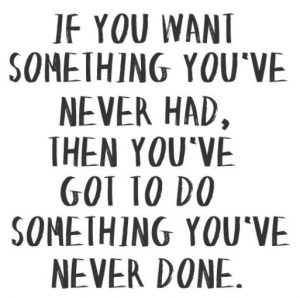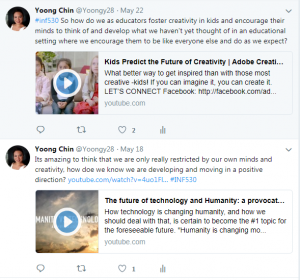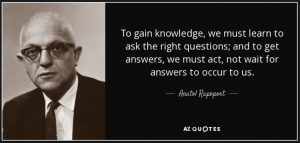As I reach the completion of the subject INF530 – Concepts and Practices for a Digital Age, I find myself reflecting on my learning journey thus far. Launching into learning for the first time at a higher education level and in an online learning platform definitely has its challenges and excitement. Coupling this with full time work and the time restrictions of adult life also provided some hurdles.
Overall all, I have found the subject to be eyeopening, challenging and exciting at the same time. Using online social media platforms in the course such as Padlet, Blogging and Twitter have challenged me to step outside of my comfort zones to collaborate and link with people for a specific purpose. These platforms have also encouraged me to share my thoughts publicly (something which I am generally hesitant to do)
Through making my way through targeted and focused course readings, I have found that I now have more questions and wonderings than when I began the course 14 weeks ago. This is, after all, just the beginning of my own personal journey into the Knowledge Networks and Digital Innovation degree.
Through using Blogging as a medium to reflect and discuss key issues raised in course content, I found it reassuring to see that there was a ‘person’ on the other side of my thoughts and sharing theirs back. This allowed connections to occur between students and with the tutor. Still being new to me as a way of communicating, I reflected on the fact that I comfortably share and contribute to people’s lives on social media platforms such as Facebook and Twitter without consideration, whereas I found contributing in an academic manner much more challenging.
When making my way through the course modules, I was able to delve into and take away the following three key learnings from a wide range of content;
Globalisation of Learning was born with the introduction of the internet and readily available personal devices. Learning now occurs anytime, anywhere, and students regularly pursue knowledge in networked and collaborative ways – with or without us. Emerging web technologies connect young people in ways never before possible. (Nussbaum-Beach 2012) This provides immeasurable opportunities for educators along with many factors such as online safety to be considered. Most expectantly, the globalisation of learning is met by educators with mixed feelings, ranging from excitement and opportunity through to fear and resistance.
Creative Cultures are key to successful learning and is one of the largest shifts that educators today need to make to cater for their new age learners. ‘Teaching creatively and for creativity is entails taking student on a creative journey where their responses are not predetermined.’ (Topic 5.1) This is a daunting shift for educators who are used to ‘controlling’ their lessons and its outcome.
Education settings however, are often criticised for not fostering maximum creativeness in their students, as described by Davies – One of the reasons why education systems have been regarded as barriers to developing and “releasing creative potential in the economy” is that the teaching focuses on “knowledge acquisition” (Davies, 2002). Through further discussion and readings, it is evident to me that many barriers hinder creativeness, many of which are systemic, structural or cost related. Teacher resistance only provides one portion of the formula to developing Creative Cultures in schools.
Re-imagining Education in a Digital Age is exciting and it is happening, irrespective of opinions and resistance. The Knowledge Network has arrived and educators now need to find the balance between teaching students to be digitally prepared whilst still formally teaching required curriculum content. With the birth of digital collaborative learning, students now require a new set of capabilities to ensure that they are future ready and employable.
This video by Mark Treadwell assists to scaffold some thinking around this idea of education in a Digital Age.
Working in Education in a newly emerging digital environment provides me with much excitement and hope. The challenge of merging my personal pedagogy of traditional teaching and learning with new aged ideas is what I look forward to throughout this journey.
Word Count – 662 words
References –
Davies, D. Creative teachers for creative learners – a literature review. Undated, Internet Available: www.ttrb.ac.uk/attachments/ c30 96c7b -da04-41ef-a7ac-50535306e8fb.pdf
Nussaum-Beach, (2012) The Connected Educator: Learning and Leading in a Digital Age Published by Solution Tree Press.
Philip, T. M., & Garcia, A. D. (2013). The Importance of still teaching the iGeneration: New technologies and the centrality of pedagogy. Harvard Educational Review, 83(2), 300–319,400–401. Retrieved from http://search.proquest.com.ezproxy.csu.edu.au/docview/1399327199?accountid=10344
Shaheen Robina (2010) Creativity and Education – Creative Education 2010. Vol.1, No.3, 166-169 Retrieved from https://files.eric.ed.gov/fulltext/ED521875.pdf
Treadwell, Mark (9 December 2017) The Future of Learning Retrieved from https://www.youtube.com/watch?v=t64KgFZcTmc&feature=youtu.be&ab_channel=MarkTreadwell
Image 1: Retrieved from https://sites.google.com/site/jmseniorproject/ (Accessed June 2018)
Image 2: Retrieved from http://www.azquotes.com/quote/525944 (Accessed June 2018)
 Image 1
Image 1


